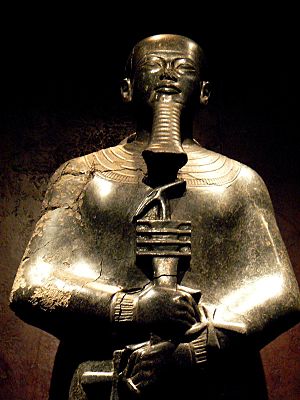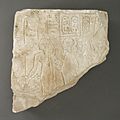Ptah facts for kids
Quick facts for kids Ptah |
|||||
|---|---|---|---|---|---|
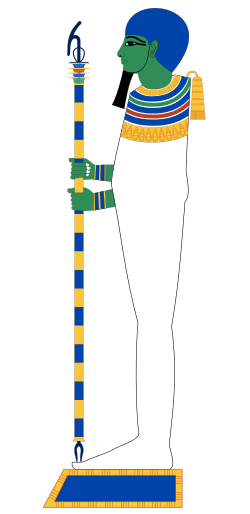
Ptah, in the form of a mummified man, standing on the symbol for Ma'at, holding a scepter or staff that bears the combined ankh-djed-was symbols
|
|||||
| Name in hieroglyphs |
|
||||
| Major cult center | Memphis | ||||
| Symbol | the djed pillar, the bull | ||||
| Consort | Sekhmet and Bast | ||||
| Offspring | Nefertem, Maahes | ||||
| Parents | none (self-created or un-created) | ||||
In ancient Egyptian mythology, Ptah was a very important god. He was seen as the creator god of Memphis, a major city in ancient Egypt. Ptah was also the god of craftsmen and architects.
In Memphis, Ptah was part of a special group of three gods, called a triad. He was the husband of the fierce goddess Sekhmet and the father of Nefertum. People also believed he was the father of the wise man Imhotep.
Contents
Who was Ptah? The Creator God
Ptah was an amazing creator god in ancient Egypt. People believed he existed before anything else. He created the world just by thinking about it! First, he thought about the world in his heart. Then, he spoke it into existence with his words.
The ancient Egyptians believed that everything in nature, like animals and plants, came from Ptah's thoughts and words. He also helped keep the world safe and made sure the pharaohs (Egyptian kings) stayed in power.
The Memphite Theology
During the Twenty-Fifth Dynasty, a Nubian pharaoh named Shabaka wrote down an old story on a stone slab. This stone is known as the Shabaka Stone. It tells the story of the Memphite Theology. This story explains how Ptah created the universe using his thoughts and words.
What was Ptah the patron of?
Ptah was the special protector, or patron, of many different skilled workers. He was the god of:
- Craftsmen
- Metalworkers
- Carpenters
- Shipbuilders
- Sculptors
Ptah's special names
Ptah had many special names, called epithets. These names described his important roles in ancient Egyptian religion and society:
- Ptah the beautiful face
- Ptah lord of truth
- Ptah master of justice
- Ptah who listens to prayers
- Ptah master of ceremonies
- Ptah lord of eternity
How was Ptah shown?
Like many gods in ancient Egypt, Ptah appeared in different ways. Sometimes he was shown as a dwarf, but he became very popular in this form later on. He was often linked with the god Bes. His worship even spread outside Egypt, especially by the Phoenicians, reaching places like Carthage.
Ptah was usually shown as a man with green skin. He looked like he was wrapped tightly in a cloth, like a mummy. He wore a divine beard and held a special staff. This staff combined three powerful symbols:
- The Was sceptre, which meant power.
- The Ankh sign, which meant life.
- The Djed pillar, which meant stability.
These three symbols together showed Ptah's creative powers: power, life, and stability.
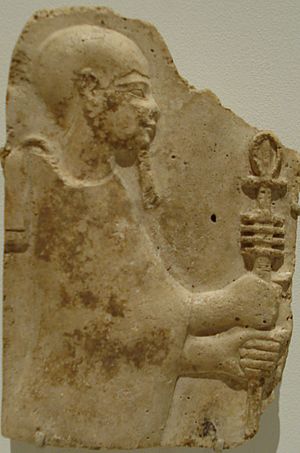
Ptah's different forms
From the Old Kingdom onwards, Ptah started to be seen in the forms of other gods from the Memphis area, like Sokar and Tatenen.
Ptah-Sokar-Osiris
When Ptah took on the form of Sokar, he was shown wrapped in a white cloth, wearing the Atef crown, which was also worn by the god Osiris. In this form, he was the protector of the burial grounds, especially Saqqara, where many royal pyramids were built. Over time, Ptah, Sokar, and Osiris combined to form a new god called Ptah-Sokar-Osiris. Small statues of this god were often placed in tombs to protect the dead on their journey to the afterlife.
Ptah-Tatenen
Ptah's Tatenen form was shown as a strong young man wearing a crown with two tall feathers and a sun disk. He represented the fire under the ground that makes the earth rumble. Because of this, metalworkers and blacksmiths especially honored him. But he was also feared because he caused earthquakes. In this form, Ptah was also the "master of ceremonies" for the Sed festival, a special event celebrating a pharaoh's first thirty years of rule.
Ptah and the Sun Gods
Ptah was sometimes linked to sun gods like Re or Aten. During the Amarna period, people believed Ptah was the divine power that helped the sun god come into being. In his temple in Memphis, Ptah would travel in a special boat during big festivals. Ptah was also symbolized by two human-headed birds with sun disks, which represented the souls of the god Re. These two "Ba" (souls) were identified as the twin gods Shu and Tefnut.
Ptah and the Apis Bull
Finally, Ptah was also seen in the sacred bull, Apis. This bull was often called a "herald of Re" (a messenger of the sun god). The Apis bull was worshipped in Memphis, likely at Ptah's great temple. When the bull died, it was buried with great honors in the Serapeum of Saqqara, as if it were a living god.
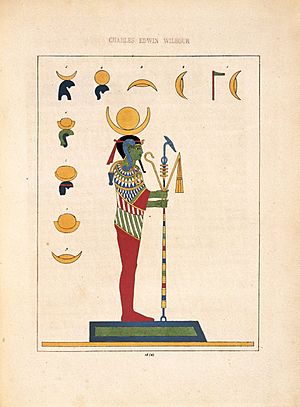
How Ptah's Worship Grew
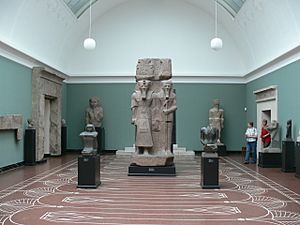
Since Ptah was the god of craftsmen, his worship quickly spread throughout Egypt. During the Old Kingdom, when many large royal buildings were made, the high priests of Ptah were very important. They worked closely with the vizier (a top official), acting as chief architects and master craftsmen. They were in charge of decorating the pharaohs' tombs.
In the New Kingdom, Ptah's worship grew even more. This happened especially in Memphis, his home city, but also in Thebes. The workers who built the royal tombs in Thebes honored Ptah as their patron god. Because of this, a special prayer place called Ptah who listens to prayers was built near Deir el-Medina, the village where these workers lived. In Memphis, Ptah's role as a god who listened to people's prayers was shown by carving large ears on the walls of his temple.
During the Nineteenth Dynasty, Ptah's worship became even stronger. He became one of the four most important gods in the empire of Ramesses. He was worshipped at Pi-Ramesses as the god of ceremonies and coronations (when a pharaoh was crowned).
In the Third Intermediate Period, Ptah became central to the monarchy again. Pharaohs were crowned in his temple. The Ptolemies (a later line of pharaohs) continued this tradition. The high priests of Ptah became very close to the royal family, with some even marrying princesses. This shows how important they were in the Ptolemaic court.
Main Places Where Ptah Was Worshipped
| Temple dedicated to | Location |
|---|---|
| Ptah | Pi-Ramesses |
| Ptah | Memphis |
| Ptah who listens to prayers | Memphis |
| Ptah who is south of his Wall | Memphis |
| Ptah-Sokar | Abydos |
| Ptah-Sokar | Kom el-Hettan (Thebes) |
| Ptah who listens to prayers | Deir el-Medina (Thebes) |
| Ptah | Karnak (Thebes) |
| Ptah | Gerf Hussein (Nubia) |
| Ptah lord of truth | Abu Simbel (Nubia) |
Images for kids
-
Relief fragment showing Imenet, Ptah and Amenhotep I; 1569–1081 BC; made of limestone; from the Los Angeles County Museum of Art (US)
-
Ptah statue; 1070–712 BC; made of bronze, gold leaf and glass; height: 29.5 cm; from the Metropolitan Museum of Art
-
Head of Ptah; 664–525 BC; made of faience with blue-green and black glaze; height: 3.5 cm; from the Walters Art Museum (Baltimore, US)
See also
 In Spanish: Ptah para niños
In Spanish: Ptah para niños


